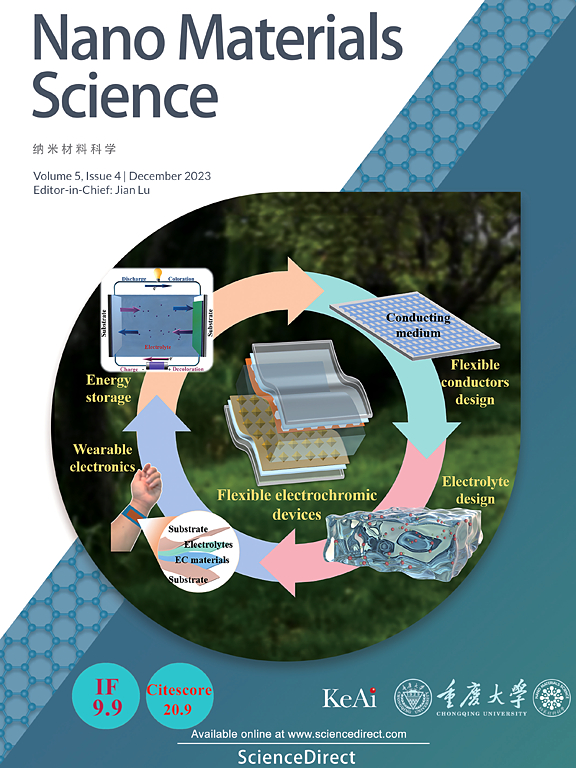铂铜压缩应变和抗氧化剂的协同作用提高了氧还原性能
IF 17.9
2区 材料科学
Q1 Engineering
引用次数: 0
摘要
开发高效、耐用的氧还原反应电催化剂对质子交换膜燃料电池(pemfc)的成功商业化具有关键意义,但仍具有挑战性。本文报道了一种分散在氮掺杂碳空心微球(Pt0.38Cu0.62/N-HCS)上的蠕虫状PtCu纳米晶体。得益于其结构和组成优势,所制得的Pt0.38Cu0.62/N-HCS催化剂具有出色的ORR电催化活性,其半波电位(E1/2)为0.837 V,质量活性为0.672 a mgPt-1, Tafel斜率为50.66 mV dec1,超过了商用Pt/C。此外,Pt0.38Cu0.62/N-HCS在整个ORR过程中遵循理想的四电子转移机制,因此对O2直接还原为H2O具有很高的选择性。值得注意的是,该催化剂还显示出高稳定性,在酸性电解质中循环10,000次后,E1/2仅下降25 mV。理论计算表明,Cu与Pt晶格的结合引起压缩应变,有效地调整了Pt活性位点的d带中心,增强了PtCu合金表面O2分子的化学吸附。因此,Pt0.38Cu0.62/N-HCS催化剂表现出更好的表面吸附O2分子的能力,加速了O2转化为* OOH的反应动力学。此外,与Pt相比,Cu原子不仅作为牺牲阳极,在PEMFCs运行过程中优先氧化,而且PtCu合金中稳定的Cu物质也有助于维持应变效应,共同提高活性和耐用性。综上所述,本研究为提高pemfc中基于pt的ORR电催化剂的活性和稳定性提供了一种有效且有前景的方法。本文章由计算机程序翻译,如有差异,请以英文原文为准。
Synergy of compress strain and antioxidant of platinum-copper for enhanced the oxygen reduction performance
The development of efficient and durable electrocatalysts for oxygen reduction reaction (ORR) holds a pivotal significance in the successful commercialization of proton exchange membrane fuel cells (PEMFCs) but is still challenging. Herein, we report a worm-liked PtCu nanocrystals dispersed on nitrogen-doped carbon hollow microspheres (Pt0.38Cu0.62/N-HCS). Benefiting from its structural and compositional advantages, the resulting Pt0.38Cu0.62/N-HCS catalyst delivers exceptional electrocatalytic activity for ORR, with a half-wave potential (E1/2) of 0.837 V, a mass activity of 0.672 A mgPt-1, and a Tafel slope of 50.66 mV dec-1, surpassing that of commercial Pt/C. Moreover, the Pt0.38Cu0.62/N-HCS follows the desired four-electron transfer mechanism throughout the ORR process, thereby displaying a high selectivity for direct reduction of O2 to H2O. Remarkably, this catalyst also showcases high stability, with only a 25 mV drop in E1/2 after 10,000 cycles in an acidic electrolyte. Theoretical calculations elucidate the incorporation of Cu into Pt lattice induces compressive strain, which effectively tailors the d band center of Pt active sites and strengthens the surface chemisorption of O2 molecules on PtCu alloys. Consequently, the Pt0.38Cu0.62/N-HCS catalyst exhibits an improved ability to adsorb O2 molecules on its surface, accelerating the reaction kinetics of O2 conversion to ∗OOH. Additionally, Cu atoms, not only serving as sacrificial anode, undergo preferential oxidation during PEMFCs operation when compared to Pt, but also the stable Cu species in PtCu alloys contributes significantly to maintaining the strain effect, collectively enhancing both activity and durability. Overall, this research offers an effective and promising approach to enhance the activity and stability of Pt-based ORR electrocatalysts in PEMFCs.
求助全文
通过发布文献求助,成功后即可免费获取论文全文。
去求助
来源期刊

Nano Materials Science
Engineering-Mechanics of Materials
CiteScore
20.90
自引率
3.00%
发文量
294
审稿时长
9 weeks
期刊介绍:
Nano Materials Science (NMS) is an international and interdisciplinary, open access, scholarly journal. NMS publishes peer-reviewed original articles and reviews on nanoscale material science and nanometer devices, with topics encompassing preparation and processing; high-throughput characterization; material performance evaluation and application of material characteristics such as the microstructure and properties of one-dimensional, two-dimensional, and three-dimensional nanostructured and nanofunctional materials; design, preparation, and processing techniques; and performance evaluation technology and nanometer device applications.
 求助内容:
求助内容: 应助结果提醒方式:
应助结果提醒方式:


